Armenian survival songs: Our story(ies) in rhyme and resistance
May 08, 2018
They say that music is the universal language, harmonizing humanity through the cadence of melody and the pulse of rhythm. Passed down through the centuries by storytellers, our folk songs have endured wars, migrations, genocide, and a host of other catastrophes, becoming the ultimate survivors of history. The new documentary, "Վերապրած երգեր | Survival Songs" tells the story of some of these songs through their children—our elders—and the importance of keeping them alive for following generations.
Youthful follies
When I was 12 years old, my papik (grandfather) was visiting our little New England suburb from Armenia. One night, he asked me to pull out a pen and write down all of the verses he could sing of the Sasuntsi (a native of Sasun, Western Armenia) folk song "Ha Nina"—from memory. I don’t remember what I said or did to convince him that I was up for such a task, but he was adamant and, if you’ve ever met a Sasuntsi—especially one of a certain age—you know that you’re better off just doing what you’re told; speaking from experience, risking their wrath is not a position in which you ever want to find yourself.
After what seemed like a century, papik had rattled off dozens of phrases in that strange but melodic dialect—most of it unfamiliar to me. As my preteen self grew increasingly bored, I searched through my mental encyclopedia for a proper excuse to return to my bubblegum pop songs—if I remember correctly, Usher’s "Yeah!" was all the rage back then. Lacking the necessary subtlety and patience for a swift exit, what ensued, instead, was a small temper tantrum on my part—then, one on his. I felt guilty for upsetting him but was relieved that I did not have to hear one more utterance of that annoying refrain, “Ha Nina Nina Nina…”
Reviving a culture through song
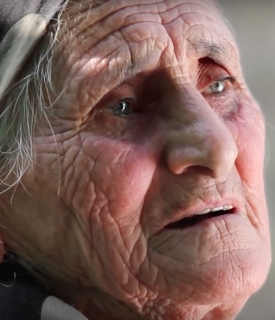 This still, taken from the CivilNet produced documentary, "Survival Songs," features a tatik singing a tune of heartbreak following the loss of a loved one. (Photo: CivilNet)
This still, taken from the CivilNet produced documentary, "Survival Songs," features a tatik singing a tune of heartbreak following the loss of a loved one. (Photo: CivilNet)A few weeks ago, CivilNet produced a documentary film, called “Վերապրած երգեր | Survival Songs,” which follows several elderly men and women, who describe their family stories of emigration from their lost homelands in Western Armenia to the current Republic of Armenia, through the songs of their ancestral villages—mainly Sasun, Mush, and Van. About a dozen songs are featured in this exquisite 40-minute ethnographic film. The interviews (conducted in Armenian, with English subtitles) are interspersed with current footage of Western Armenia—the islands of Lake Van, the lush fields of Mush, and the churches of the once majestic, now derelict, medieval town of Ani, just a painful stone’s throw from the Armenian border.
In the past month, I have watched the film over a dozen times, and have fallen in love with these beautiful tatiks and papiks (grandmas and grandpas)—the torchbearers of our ancestral musical legacy. I am fascinated by how familiar and familial they seem—like they could be my tatiks and papiks. Six months ago, I was in Van and Mush and Ani. And Sasun. During the most difficult times of the trip, I often found myself singing some of the same tunes they sang in the documentary. Like my papik, none of them, I gathered, have touched the soil and admired the landscape and prayed in the church ruins of their forefathers. These songs and the memories that accompany them are, truly, all these elders have left of their ancestral lands. If it weren’t for these tunes, Western Armenia would be all but a fairytale of the past—a story of a distant, bygone era, where Armenians lived and created and loved and fought. And lost.
Discovering truth in strange places
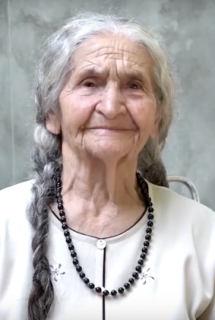 Meet Ophelia: one half of an adorable duo, who sings a selection of folk songs from the historical Armenian region of Van for the documentary, "Survival Songs." (Photo: CivilNet)
Meet Ophelia: one half of an adorable duo, who sings a selection of folk songs from the historical Armenian region of Van for the documentary, "Survival Songs." (Photo: CivilNet)After returning from Western Armenia, no one was more excited to hear about my trip than papik. Through the phone, I could hear the enthusiasm in his voice as I described, in great detail, the Sasun of his childhood tales. In that moment, he wasn’t my grandfather, but a little boy in a little village in Armenia, once again, listening to his parents describe a magical land that is no more.
As the child of survivors who lost nearly all of their loved ones in the Armenian Genocide, papik grew up with tales of mr erkir (the homeland) in his village of Sasuntsi refugees, all the while navigating through an environment of forced revisionism outside his family walls. In Soviet Armenia, the only truth to be found, he says, was in the music of his ancestors—in songs like "Ha Nina." Papik’s father was 12 years old when he escaped Sasun and near-death, losing everyone and everything he had ever known or loved. Twelve years old. At that same age, I considered listening to my grandfather singing a song as my biggest burden.
I cringe in shame thinking about this now.
You see, I’ve come to this weird realization about myself: the only time I become a raging Armenian nationalist is when I listen to our folk songs and dance our folk dances. It’s strange to explain, but usually other Sasuntsis—no matter where they were born or raised—understand. One of my dearest friends—a fellow Sasuntsi, but Beirutsi born and bred, now living in Boston—revealed the same sentiments to me recently.
It makes sense when you take, for instance, the Yarkhushta—a war dance at its core and a common staple at Sasuntsi weddings and family parties. How strange that in our happiest moments, we choose to celebrate with a dance of war—the same one our fedayis (freedom fighters) would engage in before heading to combat against encroaching Turkish and Kurdish forces more than a century ago. When the double zurna begins, the same rhythms and movements that carried our ancestors into battle infuse our soul with the Armenian spirit. Like a secret, ancient language, they beckon us to fight for all that is just and pure.
The idea that the whole world may change but these songs and dances stay firmly rooted in the history of our ancestors—that they tell the story of our ancestors—is one of the most precious things we can draw on as the inheritors of this rich culture.
Once you realize this, suddenly, a song is not just a song anymore.
But why should we care?
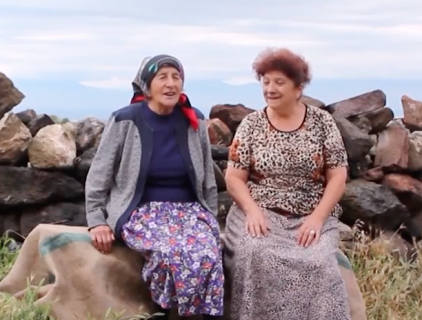 In "Survival Songs," elders remember their cultural and lineal past through music. As seen in this still, one family recreates the songs of their ancestors, who hailed from Sasun. (Photo: CivilNet)
In "Survival Songs," elders remember their cultural and lineal past through music. As seen in this still, one family recreates the songs of their ancestors, who hailed from Sasun. (Photo: CivilNet)In "Survival Songs," the papik from the village of Nerkin Bazmaberd (the village next to the one where my papik grew up) says, that we, the youth, can enjoy our modern songs and dances, but they “should not cast a shadow over the dances of our ancestors.” And they cannot. Because no modern dance beat or melody can rattle my bones the way the "Sasna Yarkhushta" or "Mayroké" or even "Ha Nina" does.
In every way, these truly are “survival songs,” and the tatiks and papiks who heartily and graciously share them with us are a testament to that. It is no surprise, then, that the documentary ends with a pumping modern rock rendition of "Zartir Lao." This Mshetsi (from Mush, Western Armenia) tune—at once a beloved lullaby and a call for rebellion against the enemy—embodies all that these folk songs represent and why we should never undervalue them.
It has taken me half a lifetime to realize that on that random day 13 years ago, I had been entrusted with one of the most precious privileges of my young life. Papik was my family’s ashugh (bard) and I was the scribe, recording our cultural legacy—our clan's story—for posterity. Reflecting on it now, I don’t think I’ve heard him sing since. Maybe I’m ascribing too much meaning to this puerile memory—I’m sure that papik has forgotten, but to this day, every time I hear "Ha Nina," I picture him in my living room, with his legs crossed on the coffee table, singing that ever-annoying refrain, only now, it’s not so annoying.
Song and man as one and the same
Though the interviewees in "Survival Songs" are all strangers, they may as well be my grandfather. Watching these beautiful souls, I yearn for the opportunity to redo that fateful scene. We aren’t all given second chances in life, but I am lucky to still have my papik—albeit older and frailer in mind now. I want nothing more than to hop on a plane to Yerevan, plop myself down next to that great man, and record every lyric that comes out of his mouth. Only this time, I will not tell him to stop.
Video
Join our community and receive regular updates!
Join now!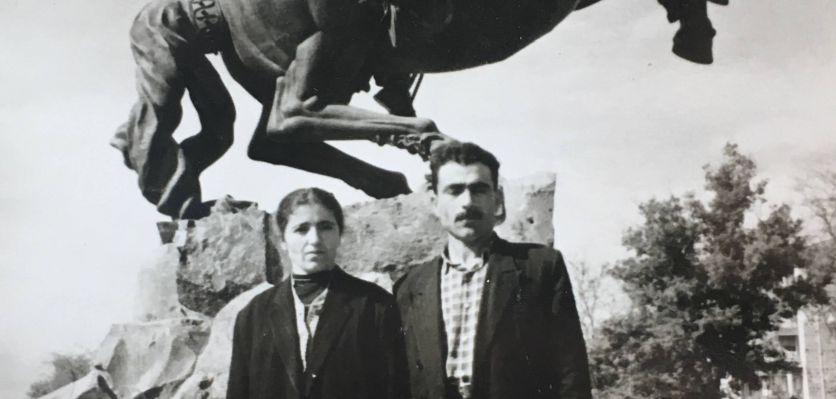


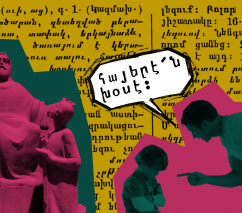

Attention!